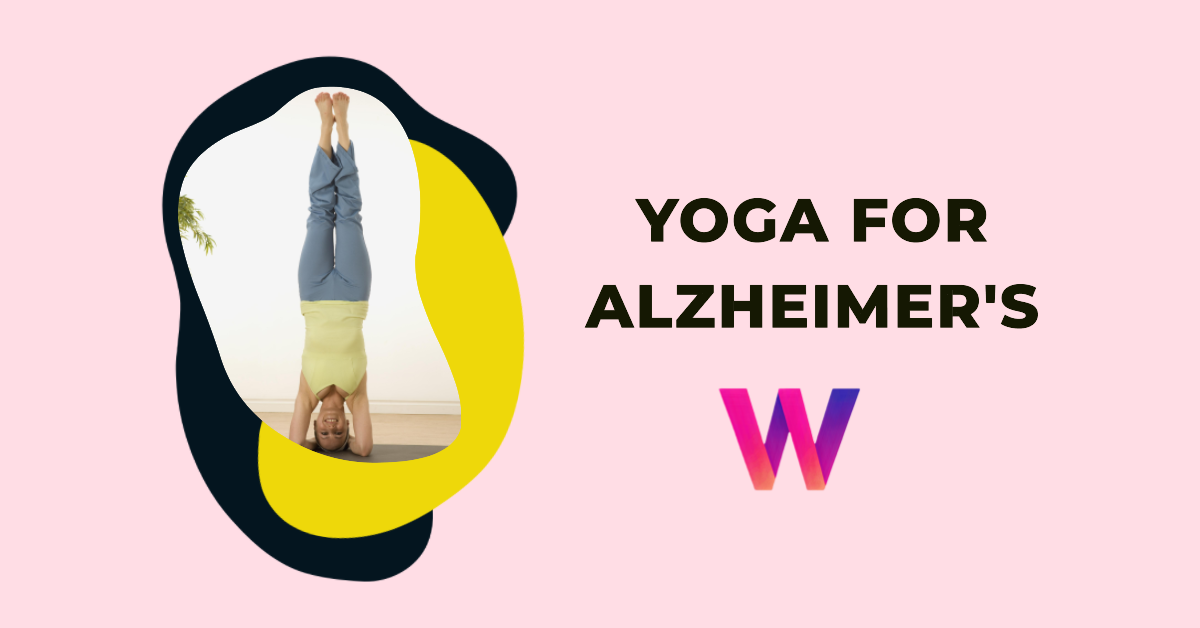Alzheimers disease is a progressive and irreversible brain disorder that affects memory, cognition, and behavior. It is the most common cause of dementia, a term that describes a group of symptoms that impair daily functioning and quality of life. According to the World Health Organization, around 50 million people worldwide have dementia, and Alzheimers disease accounts for 60-70% of the cases.
There is currently no cure for Alzheimers disease, and most treatments focus on managing the symptoms and slowing down the progression of the disease. However, some studies suggest that yoga, a mind-body practice that combines physical postures, breathing exercises, and meditation, may have beneficial effects for people with Alzheimer’s disease and their caregivers.
Table of Contents
Here, I will explore how yoga can help people with Alzheimers disease by:
- Improving mood and reducing stress
- Enhancing memory and cognitive function
- Supporting brain health and neuroplasticity
- Providing social and emotional support
How Yoga Improves Mood and Reduces Stress
One of the common psychological effects of Alzheimers disease is depression, anxiety, agitation, and paranoia. These emotional disturbances can worsen the cognitive decline and impair the quality of life of the patients and their caregivers.
Yoga can help in reducing stress and improving mood by activating the parasympathetic nervous system, which is responsible for relaxation and healing. Yoga also stimulates the release of endorphins, serotonin, and dopamine, which are neurotransmitters that regulate mood, happiness, and well-being.
Several studies have shown that yoga can reduce depression, anxiety, and stress in older adults with mild cognitive impairment (MCI), a risk factor for dementia and Alzheimer’s disease. For example, a 2016 study published in the Journal of Alzheimer’s Disease found that participants who practiced yoga over a 12-week period experienced improvements in mood and in visual and verbal memory for up to six months. Another study published in 2017 in the International Journal of Geriatric Psychiatry found that yoga improved depressive symptoms and quality of life in older adults with MCI compared to a control group.
How Yoga Enhances Memory and Cognitive Function
Memory loss is one of the hallmark symptoms of Alzheimers disease, affecting both short-term and long-term memory. People with Alzheimer’s disease may also have difficulty with language, communication, reasoning, judgment, and attention.
Yoga can help in enhancing memory and cognitive function by improving blood flow, oxygenation, and glucose metabolism in the brain. Yoga also increases the levels of brain-derived neurotrophic factor (BDNF), a protein that supports the growth and survival of neurons and synapses. BDNF is essential for learning, memory, and neuroplasticity.
Several studies have shown that yoga can improve memory and cognitive function in older adults with MCI or mild to moderate Alzheimer’s disease. For example, a 2018 study published in the Journal of Clinical Neurology found that yoga improved verbal memory, visuospatial memory, executive function, attention, processing speed, and mental flexibility in older adults with MCI compared to a control group. Another study published in 2019 in the Journal of Alternative and Complementary Medicine found that yoga improved verbal memory, verbal fluency, visuospatial memory, and executive function in older adults with mild to moderate Alzheimer’s disease compared to a control group.
How Yoga Supports Brain Health and Neuroplasticity
Alzheimer’s disease is characterized by the accumulation of amyloid plaques and neurofibrillary tangles in the brain, which damage the neurons and disrupt the communication between them. This leads to brain atrophy, or shrinkage of brain tissue, especially in areas related to memory, cognition, and emotion.
Yoga can help in supporting brain health and neuroplasticity by increasing the gray matter volume and cortical thickness in the brain. Gray matter consists of neuronal cell bodies and dendrites, which are involved in processing information and forming memories. Cortical thickness refers to the thickness of the outer layer of the brain (the cortex), which is responsible for higher cognitive functions such as language, reasoning, decision-making, and awareness.
Several studies have shown that yoga can increase gray matter volume and cortical thickness in older adults with MCI or mild to moderate Alzheimer’s disease. For example, a 2016 study published in the Journal of Alzheimer’s Disease found that participants who practiced yoga over a 12-week period showed increased gray matter volume in areas related to memory (the hippocampus), emotion (the amygdala), attention (the prefrontal cortex), and visual processing (the occipital cortex) compared to a control group. Another study published in 2017 in Frontiers in Aging Neuroscience found that participants who practiced yoga over a 12-week period showed increased cortical thickness in areas related to memory (the entorhinal cortex), language (the superior temporal gyrus), and executive function (the anterior cingulate cortex) compared to a control group.
How Yoga Provides Social and Emotional Support
Alzheimers disease can be a lonely and isolating condition, affecting not only the patients but also their caregivers. People with Alzheimers disease may feel embarrassed, frustrated, angry, or hopeless about their condition. They may also withdraw from social activities and relationships, losing their sense of identity and purpose. Caregivers may also experience stress, burnout, guilt, grief, and resentment as they cope with the challenges and demands of caring for their loved ones.
Yoga can help in providing social and emotional support by creating a sense of community and belonging among people with Alzheimer’s disease and their caregivers. Yoga can also foster a positive attitude, self-compassion, gratitude, and acceptance of oneself and others. Yoga can also enhance the emotional bond and communication between the patients and their caregivers, improving their relationship quality and satisfaction.
Several studies have shown that yoga can improve social and emotional well-being in older adults with MCI or mild to moderate Alzheimers disease and their caregivers. For example, a 2017 study published in the Journal of Bodywork and Movement Therapies found that yoga improved social functioning, self-esteem, self-efficacy, and quality of life in older adults with MCI compared to a control group. Another study published in 2018 in the Journal of Gerontological Nursing found that yoga improved caregiver burden, depression, anxiety, stress, coping skills, and quality of life in caregivers of older adults with dementia compared to a control group.
[Also Read: How to Improve Memory in Children]
Conclusion
Yoga is a safe, effective, and enjoyable practice that can benefit people with Alzheimer’s disease and their caregivers in multiple ways. Yoga can improve mood and reduce stress, enhance memory and cognitive function, support brain health and neuroplasticity, and provide social and emotional support. Yoga can also complement other treatments and interventions for Alzheimer’s disease, such as medication, cognitive stimulation, physical activity, nutrition, and music therapy.
If you or your loved one has Alzheimer’s disease or is at risk of developing it, you may want to consider adding yoga to your daily routine. You can start with simple and gentle yoga poses, breathing exercises, and meditation techniques that are suitable for your level of ability and comfort. You can also join a yoga class or group that is specially designed for older adults or people with cognitive impairment. You may find that yoga not only helps you cope with the symptoms of Alzheimer’s disease but also enhances your overall health and happiness.
FAQs
Q: What are some examples of yoga poses that are good for people with Alzheimer’s disease?
A: Some examples of yoga poses that are good for people with Alzheimer’s disease are:
- Mountain pose (Tadasana): This pose helps in improving posture, balance, awareness, and confidence. Stand with your feet hip-width apart, toes pointing forward. Engage your legs and core muscles. Lift your chest and relax your shoulders. Lengthen your spine and crown of your head. Bring your palms together in front of your heart or let them hang by your sides. Breathe deeply and evenly.
- Tree pose (Vrksasana): This pose helps in improving balance, concentration, coordination, and memory. Stand in mountain pose. Shift your weight to your right foot and lift your left foot off the floor. Place the sole of your left foot on your right inner thigh or calf (avoid the knee). Press your left foot into your right leg and vice versa. Bring your palms together in front of your heart or extend them overhead. Gaze at a fixed point in front of you or close your eyes. Breathe deeply and evenly. Repeat on the other side.
- Cat-cow pose (Marjaryasana-Bitilasana): This pose helps in improving flexibility, mobility, circulation, and digestion. Come to all fours on a mat or a blanket. Align your wrists under your shoulders and your knees under your hips. As you inhale, lift your chest and tailbone up, arching your back. Look up or forward. As you exhale, round your back and tuck your chin to your chest. Draw your navel toward your spine. Look down or between your legs. Repeat this movement several times with your breath.
- Child’s pose (Balasana): This pose helps in relaxing the body and mind, releasing tension, stress, and anxiety. From all fours, bring your big toes together and separate your knees as wide as comfortable. Sit back on your heels and lower your torso between or over your thighs. Extend your arms forward or alongside your body. Rest your forehead on the mat or a pillow. Breathe deeply and evenly.
Q: What are some examples of breathing exercises that are good for people with Alzheimer’s disease?
A: Some examples of breathing exercises that are good for people with Alzheimer’s disease are:
- Diaphragmatic breathing (Belly breathing): This exercise helps in calming the nervous system, reducing stress, and improving oxygen delivery to the brain. Sit or lie down comfortably. Place one hand on your chest and the other on your belly. Breathe in through your nose and feel your belly expand. Breathe out through your mouth and feel your belly contract. Keep your chest still and focus on your breath. Repeat this for several minutes.
- Alternate nostril breathing (Nadi shodhana): This exercise helps in balancing the left and right hemispheres of the brain, enhancing mental clarity, focus, and memory. Sit comfortably with a straight spine. Bring your right hand to your nose and use your thumb to close your right nostril. Breathe in through your left nostril. Then use your ring finger to close your left nostril and release your thumb. Breathe out through your right nostril. Then breathe in through your right nostril. Then close your right nostril with your thumb and release your ring finger. Breathe out through your left nostril. This is one cycle. Repeat this for several cycles.
- Humming bee breath (Bhramari): This exercise helps in relaxing the mind, reducing anxiety, and improving concentration. Sit comfortably with a straight spine. Close your eyes and relax your face. Bring your index fingers to your ears and gently press the cartilage. Breathe in through your nose and breathe out slowly while making a humming sound like a bee. Feel the vibration in your head and chest. Repeat this for several times.
Q: What are some examples of meditation techniques that are good for people with Alzheimers disease?
A: Some examples of meditation techniques that are good for people with Alzheimer’s disease are:
- Mindfulness meditation: This technique helps in cultivating awareness, attention, and acceptance of the present moment, without judgment or distraction. Sit or lie down comfortably. Close your eyes or lower your gaze. Bring your attention to your breath, noticing its natural rhythm and sensations. Whenever you notice that your mind has wandered to thoughts, feelings, or sensations, gently acknowledge them and bring your attention back to your breath. Do this for as long as you wish.
- Mantra meditation: This technique helps in focusing the mind, enhancing memory, and creating positive vibrations. Sit comfortably with a straight spine. Close your eyes or lower your gaze. Choose a word, phrase, or sound that is meaningful to you, such as “peace”, “love”, “om”, or “soham”. Repeat it silently or aloud with each breath, synchronizing it with your inhalation and exhalation. If you lose track of the mantra, simply start again from where you left off.
- Loving-kindness meditation (Metta): This technique helps in cultivating compassion, empathy, and kindness for oneself and others. Sit comfortably with a straight spine. Close your eyes or lower your gaze. Bring to mind someone who is dear to you, such as a family member, friend, or pet. Feel the warmth and affection you have for them in your heart. Repeat these phrases silently or aloud: “May you be happy. May you be healthy. May you be safe. May you be at peace.” Then bring to mind someone who is neutral to you, such as a neighbor, colleague, or stranger. Repeat the same phrases for them. Then bring to mind someone who is difficult to you, such as an enemy, critic, or rival. Repeat the same phrases for them. Finally, bring to mind yourself and repeat the same phrases for yourself.



